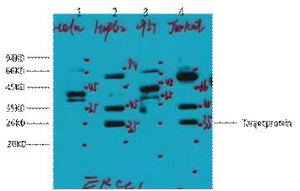OPTN rabbit pAb
- Catalog No.:YT8067
- Applications:WB
- Reactivity:Human;Mouse;Rat
- Target:
- OPTN
- Fields:
- >>Mitophagy - animal;>>Amyotrophic lateral sclerosis;>>Pathways of neurodegeneration - multiple diseases
- Gene Name:
- OPTN FIP2 GLC1E HIP7 HYPL NRP
- Protein Name:
- OPTN
- Human Gene Id:
- 10133
- Human Swiss Prot No:
- Q96CV9
- Mouse Gene Id:
- 71648
- Mouse Swiss Prot No:
- Q8K3K8
- Rat Gene Id:
- 246294
- Rat Swiss Prot No:
- Q8R5M4
- Immunogen:
- Synthesized peptide derived from human OPTN
- Specificity:
- This antibody detects endogenous levels of OPTN at Human, Mouse,Rat
- Formulation:
- Liquid in PBS containing 50% glycerol, 0.5% BSA and 0.02% sodium azide.
- Source:
- Polyclonal, Rabbit,IgG
- Dilution:
- WB 1:500-2000
- Purification:
- The antibody was affinity-purified from rabbit antiserum by affinity-chromatography using epitope-specific immunogen.
- Concentration:
- 1 mg/ml
- Storage Stability:
- -15°C to -25°C/1 year(Do not lower than -25°C)
- Other Name:
- Optineurin (E3-14.7K-interacting protein) (FIP-2) (Huntingtin yeast partner L) (Huntingtin-interacting protein 7) (HIP-7) (Huntingtin-interacting protein L) (NEMO-related protein) (Optic neuropathy-inducing protein) (Transcription factor IIIA-interacting protein) (TFIIIA-IntP)
- Observed Band(KD):
- 65kD,42kD
- Subcellular Location:
- Cytoplasm, perinuclear region. Golgi apparatus . Golgi apparatus, trans-Golgi network. Cytoplasmic vesicle, autophagosome. Cytoplasmic vesicle. Recycling endosome. Found in the perinuclear region and associates with the Golgi apparatus (PubMed:27534431). Colocalizes with MYO6 and RAB8 at the Golgi complex and in vesicular structures close to the plasma membrane. Localizes to LC3-positive cytoplasmic vesicles upon induction of autophagy. .
- Expression:
- Present in aqueous humor of the eye (at protein level). Highly expressed in trabecular meshwork. Expressed nonpigmented ciliary epithelium, retina, brain, adrenal cortex, fetus, lymphocyte, fibroblast, skeletal muscle, heart, liver, brain and placenta.
- June 19-2018
- WESTERN IMMUNOBLOTTING PROTOCOL
- June 19-2018
- IMMUNOHISTOCHEMISTRY-PARAFFIN PROTOCOL
- June 19-2018
- IMMUNOFLUORESCENCE PROTOCOL
- September 08-2020
- FLOW-CYTOMEYRT-PROTOCOL
- May 20-2022
- Cell-Based ELISA│解您多样本WB检测之困扰
- July 13-2018
- CELL-BASED-ELISA-PROTOCOL-FOR-ACETYL-PROTEIN
- July 13-2018
- CELL-BASED-ELISA-PROTOCOL-FOR-PHOSPHO-PROTEIN
- July 13-2018
- Antibody-FAQs



